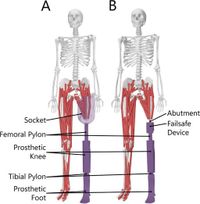In a groundbreaking study examining osseointegration (OI) in lower limb prosthetics, researchers have uncovered important insights into the mechanical energetics of walking among individuals with unilateral transfemoral limb loss. The study, conducted at the Walter Reed National Military Medical Center, focused on a group of eight service members who underwent the OI procedure, highlighting the advantages and unexpected challenges associated with this advanced surgical technique.
Osseointegration, which entails the direct anchoring of a prosthesis to the residual bone, aims to alleviate common issues faced by amputees, particularly problems with traditional socket interfaces. One significant benefit of OI is the enhanced quality of life reported by users; however, despite its advantages, this new research reveals that individuals walking with an OI interface may experience increased mechanical energetic asymmetry compared to those using socket prosthetics.
To assess the mechanical differences between the two prosthetic interfaces, the research team employed custom biomechanical modeling and collected gait analysis data of participants pre-operation and approximately 24 months post-OI. The findings revealed that relative to a socket interface, the OI interface shifted loads toward the intact limb, resulting in increased collision losses while maintaining minimal net work of both the prosthetic and intact limbs.
The core of the study's findings suggest that while one might expect improved efficiency with the removal of the socket component, the reality is more nuanced. Specifically, the research indicates that despite a potential average savings of approximately 6 joules of work per stride, this decrease does not significantly alter the overall joint work performance. Rather, the OI interface was linked to an increase in mechanical energetic asymmetry during ambulation.
Significant findings included that on the intact limb, there was a 0.07 J kg-1 increase in positive work when compared to the socket interface, while on the prosthetic limb, there was a 0.10 J kg-1 reduction in negative work during fast walking speeds with an OI interface. Moreover, during load acceptance, socket compression contributed to 0.14 J kg-1 of negative work at slow speeds and 0.17 J kg-1 at fast speeds. These values underscore the complex dynamics at play when transitioning to an OI prosthetic limb.
Interestingly, the study also uncovered that on the intact limb, peak vertical ground reaction forces were 0.55 N kg-1 larger with an OI compared to a socket interface, while the prosthetic limb recorded maximum values that were 1.03 N kg-1 smaller. These findings lead to broader implications regarding the long-term joint health of both the intact and prosthetic limbs post-OI, particularly concerning the offloading strategies required for maintaining balance between the limbs.
As the implications of the research unfold, experts urge caution for future prosthesis designs and rehabilitation frameworks, advocating the need for tailored approaches that prioritize patient comfort without compromising on physical capabilities. "Our findings suggest that despite previously reported improvements in walking economy, after OI individuals likely walk with increased mechanical energetic asymmetry," the authors emphasize.
Given the prevalence of amputations among military veterans and the growing interest in advanced prosthetic solutions, this study is poised to inform not only clinical practices but also future research trajectories. Continuous assessment of mechanical energetics and joint health will be critical in optimizing rehabilitation for individuals transitioning to the use of osseointegrated prostheses, ensuring both quality of life and functional efficacy.
Future research will also need to delve deeper into the mechanisms driving the observed loading increases on the intact side, as well as explore potential strategies to balance these effects to enhance overall walking experience while mitigating the risk of joint degeneration over time.

